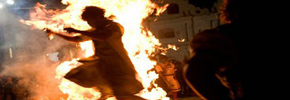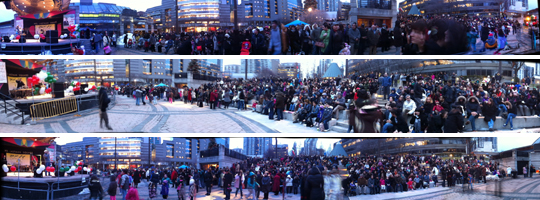Sima Sahar Zerehi – We’ve been going at it all wrong. We were looking for revolutionaries in Iran when we should have been really looking for counter-revolutionaries. It’s a common error, with so many revolutions springing up all over the region; it’s easy to make the mistake.
You see the Islamic Government of Iran calls itself a revolutionary government as they came to power by coopting the 1979 Iranian revolution. Hence, in the Iranian vernacular “revolutionaries” are supporters of the regime and “anti-revolutionaries” are those who oppose their political aims.
Under the pretence of being the victors of a revolution, for over thirty years, the Iranian regime has been able to use a distorted form of political Islam coupled with the iron hand of oppression to control our people.
A generation has grown up under the claustrophobic atmosphere of their rule. To survive this generation of young people, who make up over 70 percent of the total population in the country, has learned to take shallow breaths and perform contortions with their bodies in order to survive within the allotted confines.
In order to quash the youth’s attempts to adapt and thrive under these conditions, intermittently, the regime intensifies the pressure, denying even more oxygen to the already asthmatic population and pushing in the walls to further close in the spaces.
But this time they went too far. In a country plagued by censorship, political oppression, gender persecution, unemployment and youth ennui, national celebrations take on monumental importance.
Paramount amongst these celebrations is Nowruz, the Iranian New Year. Despite various foreign invasions and attempts at religious indoctrination, no other holiday or festival has ever been able to sideline Nowruz as Iran’s most widely celebrated event.
In Iran, Nowruz officially begins with Chaharshanbe-suri (Wednesday Feast), a Fire Festival rooted in the Zoroastrian tradition. Chaharshanbe-suri as its name suggests falls on the eve of the Wednesday preceding Nowruz and is marked by building bonfires and igniting firecrackers.
This youthful fire festival entails people jumping over bonfires as a kind of cleansing ritual in preparation for the New Year. As people jump over the fire they cast all that is yellow and sickly within them into the flames in exchange for the fires healthy and red glow.
For most Iranians such national celebrations play the essential role of acting as pressure valves, releasing built-up tensions that are part and parcel of life under a tyrannical regime.
Once again, this year, Iranian authorities made the mistake of trying to rob Iranian youth of these modest festivities.
There was good reason for the regime to fear crowds on Chaharshanbe-suri this year. After all, the fires of revolution had been ignited all over the region and even the Islamic regime had to acknowledge that the symbolism of the Fire Festival coupled with the call for political change by the reinvigorated protest-movements in the country was ripe with metaphoric undertones. To make matters even more critical for the regime, the Green movement had called for a day of protest on March 15th.
The regime, fearful of another successful wave of street protests went on the offensive. Their tactic was simple; they were going to declare the festival a danger to the public.
Leading up to March 15th, the eve of the Fire Festival, Iranian lawmakers, issued numerous statements warning the public about the dangers of partaking in the annual street festival.
Mohsen Khancherli, Tehran’s deputy police chief announced that police forces had been actively working to control the festivities by confiscating explosive materials as well as homemade firecrackers.
Alireza Avaei, the head of the Tehran judiciary, also added his two-cents by warning youth to not go out in the streets, as they may be confused with so called “anti-revolutionaries.”
In short, the regime used its state-controlled media apparatus to project a vision of itself as a concerned patriarch over its foolish and unruly charges, the youth of Iran. A tactic recently espoused by Libyan dictator, Muammar Gaddafi.
Not surprisingly, when the Iranian regime tries to deny people their celebrations, festivities like Chaharshanbe-suri become occasions of resistance.
As such, due to the foolish actions of an oppressive regime, a non-politicized New Year tradition took on political overtones. This year as youth in Iran gathered to erect bonfires, they cast images of Khamenei (the current Supreme Leader of Iran) into the flames.
Instead of scaring the public into compliance, the actions of the Iranian government, served to ignite a spark of rebellion in the country.
Reports indicate that large crowds gathered in various major cities in Iran particularly in Shiraz and Tehran on the eve of the Fire Festival. Youth erected numerous bonfires and discharged firecrackers late-into the evening.
Gangs of Basiji’s on motorcycles who circled the streets in attempts to extinguish the fires and disperse the crowds were met with militant chants calling for the fall of Khamenei.
In addition to the sound of firecrackers, many eyewitnesses reported the firing of gunshots by security forces as well as several violent clashes in areas where crowds of youth were confronted by armed guards.
According to Iranian state controlled news agencies 467 people were arrested at the annual festival for charges ranging from disturbing the peace to building and discharging explosives.
In a desperate attempt to justify this crackdown on youth, the state controlled media agency FARS manufactured an extensive report on March 16th including photographs, outlining the dangers of the annual fire festival.
Pictures of maimed and burned victims from various hospitals were exhibited to showcase that Chaharshanbe-suri was a public danger and that the crackdown against youth commemorating this annual ritual was undertaken in the name of public safety.
But Iranians have learned to read between the lines of political spin. In the end, another holiday in Iran has been politicised.
For youth in the streets of Iran, dodging the Basiji’s on motorcycles, the only wish cast into the fires was: may the cleansing fires of change sweep through our homeland.
As we jumped over bonfires on Chaharshanbe-suri in preparation for Eid we cast the oppression, tyranny, and censorship of the dictatorships in our region into the flames and asked the fire to cleanse the Middle East by igniting our revolutionary sparks.
If the events at Chaharshanbe-suri are any indication, we have exciting but arduous tasks before us in the coming year. So while, we unite as allies across linguistic and cultural lines to strengthen our resolve for the battles ahead we must also remember to come together as neighbours, friends, and family to celebrate.
After all, it is the freedoms, the joys of the everyday pleasures, the music, dance, art and culture that feeds the soul and strengthens the heart.
As the youth in Iran have continued to illustrate, a revolution that denies its people of the very freedoms and celebrations that make life worth living, is no revolution at all.







“the call for political change by the (reinvigorated) protest-movements”
That made me laugh. For all the posturing of protest movements, it’s just NOT gonna happen, sorry to say. There once was a time which now is ancient history when there also once was a time to topple that regime and that was when MILLIONS were in the street.
However you will have to think back and say WHO sent them home? Then WHY?
Now do you honestly think the regime who knows the aspirations of people will EVER allow anything approaching that time to raise it’s head one more time? Your only hope will be that the rest of the Arab countries will move in to take out that regime, but that isn’t going to happen either, because the Quran will be invoked, which calls for no violence upon other muslims.
Solution: If your educated, and want freedom, you will never find it within any muslim country, so use your head as to what the next step has to be. You will hate to hear this message, which is another sign of looking the other way for relief from a problem.